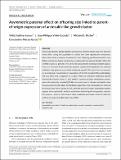Files in this item
Asymmetric paternal effect on offspring size linked to parent-of-origin expression of an insulin-like growth factor
Item metadata
| dc.contributor.author | Saldivar Lemus, Yolitzi | |
| dc.contributor.author | Vielle-Calzada, Jean-Philippe | |
| dc.contributor.author | Ritchie, Michael G. | |
| dc.contributor.author | Macías Garcia, Constantino | |
| dc.date.accessioned | 2017-05-16T09:30:12Z | |
| dc.date.available | 2017-05-16T09:30:12Z | |
| dc.date.issued | 2017-06 | |
| dc.identifier | 250005598 | |
| dc.identifier | f577a130-e1eb-49c6-aafe-0f65fe7e8017 | |
| dc.identifier | 85019230331 | |
| dc.identifier | 000403884700036 | |
| dc.identifier.citation | Saldivar Lemus , Y , Vielle-Calzada , J-P , Ritchie , M G & Macías Garcia , C 2017 , ' Asymmetric paternal effect on offspring size linked to parent-of-origin expression of an insulin-like growth factor ' , Ecology and Evolution , vol. 7 , no. 12 , pp. 4465-4474 . https://doi.org/10.1002/ece3.3025 | en |
| dc.identifier.issn | 2045-7758 | |
| dc.identifier.other | crossref: 10.1002/ece3.3025 | |
| dc.identifier.other | ORCID: /0000-0001-7913-8675/work/46761157 | |
| dc.identifier.uri | https://hdl.handle.net/10023/10781 | |
| dc.description | Research was supported by PAPIIT grant IN216111 (CMG), CONACyT PhD scholarship 351769 (YSL), and the Howard Hughes International Research Program (JPVC). | en |
| dc.description.abstract | Sexual reproduction brings together reproductive partners whose long-term interests often differ, raising the possibility of conflict over their reproductive investment. Males that enhance maternal investment in their offspring gain fitness benefits, even if this compromises future reproductive investment by iteroparous females. When the conflict occurs at a genomic level, it may be uncovered by crossing divergent populations, as a mismatch in the coevolved patterns of paternal manipulation and maternal resistance may generate asymmetric embryonic growth. We report such an asymmetry in reciprocal crosses between populations of the fish Girardinichthys multiradiatus. We also show that a fragment of a gene which can influence embryonic growth (Insulin-Like Growth Factor 2; igf2) exhibits a parent-of-origin methylation pattern, where the maternally inherited igf2 allele has much more 5′ cytosine methylation than the paternally inherited allele. Our findings suggest that male manipulation of maternal investment may have evolved in fish, while the parent-of-origin methylation pattern appears to be a potential candidate mechanism modulating this antagonistic coevolution process. However, disruption of other coadaptive processes cannot be ruled out, as these can lead to similar effects as conflict. | |
| dc.format.extent | 10 | |
| dc.format.extent | 1135207 | |
| dc.language.iso | eng | |
| dc.relation.ispartof | Ecology and Evolution | en |
| dc.subject | Antagonistic coevolution | en |
| dc.subject | Goodeidae | en |
| dc.subject | Matrotrophy | en |
| dc.subject | Parental investment | en |
| dc.subject | Sexual conflict | en |
| dc.subject | Viviparous fish | en |
| dc.subject | QH301 Biology | en |
| dc.subject | QH426 Genetics | en |
| dc.subject | NDAS | en |
| dc.subject.lcc | QH301 | en |
| dc.subject.lcc | QH426 | en |
| dc.title | Asymmetric paternal effect on offspring size linked to parent-of-origin expression of an insulin-like growth factor | en |
| dc.type | Journal article | en |
| dc.contributor.institution | University of St Andrews. School of Biology | en |
| dc.contributor.institution | University of St Andrews. Centre for Biological Diversity | en |
| dc.contributor.institution | University of St Andrews. Institute of Behavioural and Neural Sciences | en |
| dc.identifier.doi | https://doi.org/10.1002/ece3.3025 | |
| dc.description.status | Peer reviewed | en |
| dc.identifier.url | http://onlinelibrary.wiley.com/doi/10.1002/ece3.3025/full#footer-support-info | en |
This item appears in the following Collection(s)
Items in the St Andrews Research Repository are protected by copyright, with all rights reserved, unless otherwise indicated.

